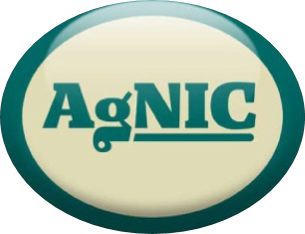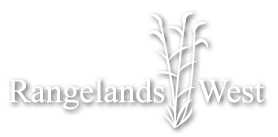Researchers: Retta Bruegger, Megan Machmuller and Seth Urbanowitz
This project was funded by a Western Sustainable Agriculture Research and Education (WSARE) Professional-Producer Grant, received in 2020.
Summary
- We undertook a three-year study (2020-2023) in two locations in western Colorado to assess the efficacy of compost on irrigated pasture on yield, soil organic carbon, and soil health. We compared compost to 1) synthetic fertilizer, 2) a combination of fertilizer and compost, and 3) controls (no application).
- We did not detect differences among treatments in soil organic carbon and soil health metrics after 2 years across treatments.
- Compost plots were less productive (p = 0.008; 1,585+458) compared to fertilized plots and were not different than controls (i.e., untreated).
- Salts were not an issue despite high application rates.
- Results on the efficacy of a 1-time application of compost to increase yield, soil organic carbon, and soil health on irrigated pasture are mixed across many studies (Kutos et al. 2023). Thus, there is risk involved in this practice as the costs are significant and may not produce comparable yields to fertilizer in irrigated pasture, and soil benefits may be slow to emerge.
Recommendations
- If compost is the right choice for an operation depends on context and goals of an operation.
- In order to maximize the potential benefits and reduce risk, we recommend:
- Timing the application of compost so that organic nitrogen in compost has time to mineralize and can be used by the crop (i.e., fall application for cool-season irrigated pasture in CO may be preferable to a spring application).
- Incorporating compost, using as harrowing or other methods, in irrigated pasture to reduce losses.
- Testing compost before application to choose the appropriate compost for your crop, and to calculate application rates.
- Calculating the compost rate (lbs/acre) based on nitrogen demand of the crop, supply in the compost, presumed mineralization rates, and soil tests to supply the desired lbs/N per acre.
- Soils change slowly, and soil health benefits may take longer to emerge than the 2-year timeframe of this study.
Background
There is a lot of interest in improving soil health, sequestering carbon in agricultural soils, and using alternatives to commercial fertilizer. Research in California indicated a 1-time application of compost increased soil organic matter content, enhanced plant growth, and contributed to climate change mitigation in California’s rangelands (Silver et al 2018). Though promising, these results are untested in western Colorado, and were from rangelands, not irrigate pastures, which is more intensively managed.
With these interests and past research in mind, we applied for a Western SARE Professional Producer grant and were funded in 2020 to implement a 3 year treatment comparing compost with commercial fertilizer in irrigated pasture in western Colorado, specifically Mesa and Ouray Counties.
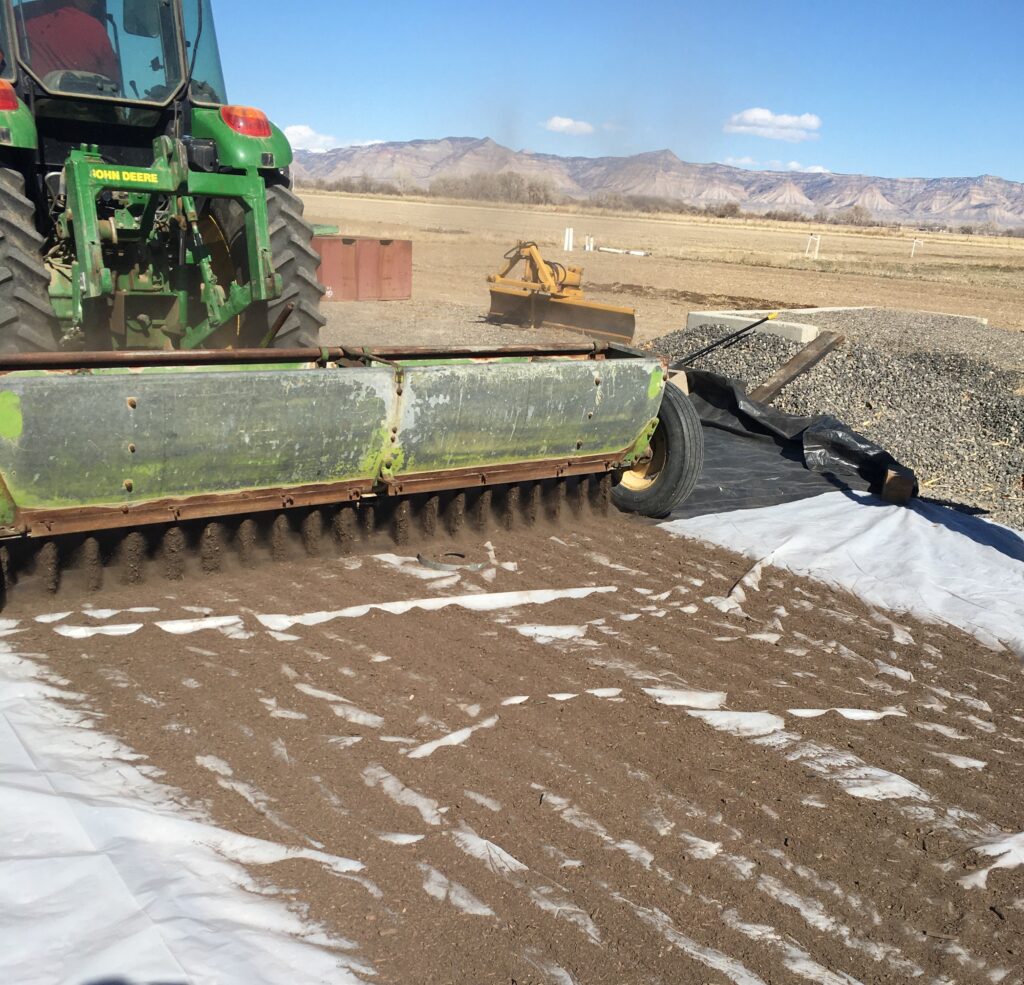
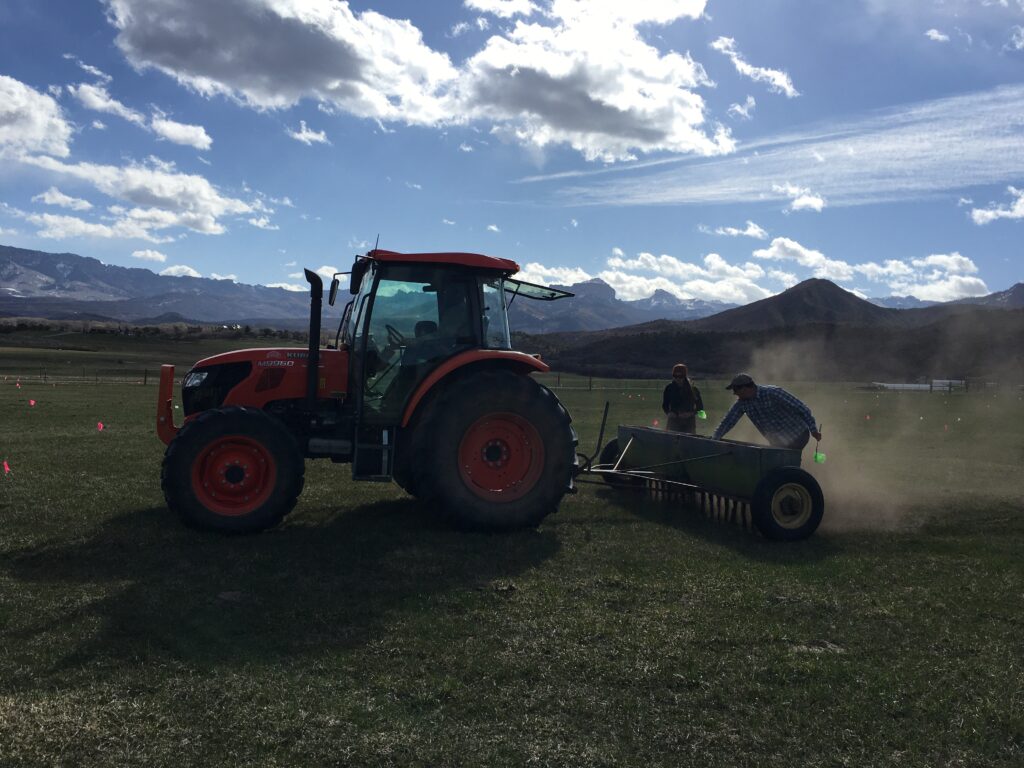
What rate did we use to apply compost?
We based the rate (tons/ acre) on the nitrogen demand of the crop relative to the available nitrogen in the compost (See below table). We also used assumptions about nitrogen mineralization rates and availability in the compost (20% of total N estimated to be plant available in year 1 – (Ward Labs Soil Test Guide).
The amount of compost we applied was quite expensive, ranging from 10 -18 tons per acre (compost was $45/ton + delivery), with 6 tons per acre used in the fertilizer plus compost treatment. This would be cost-prohibitive for most farmers and ranchers. However, influence on carbon and other characteristics would likely be observable at such a high rate. As such, we decided to apply at these rates, because the goal of the study is to first answer the question ‘does it work?’ Further, one of the primary goals of the study is to test the practice in the context of emerging carbon markets. We would not assume farmers and ranchers would invest this much in compost without a payment for doing so in a carbon market framework.
| Site | Treatment | Compost Mass (tons/acre) | Compost-C (tons/acre) | Compost-N (lbs/acre) | Fert-N (lbs/acre) | P (lbs/acre) | K (lbs/acre) |
| Ridgway | Compost | 18.8 | 4.69 | 90 | — | 347 | 628 |
| Fruita | Compost | 10.4 | 2.60 | 50 | — | 193 | 349 |
| Ridgway | Fert+Compost | 6 | 1.50 | 28.8 | 61.2 | 111 | 201 |
| Fruita | Fert+Compost | 6 | 1.50 | 28.8 | 21.2 | 111 | 201 |
| Ridgway | Fert | 0 | — | — | 90 | 50 | — |
| Fruita | Fert | 0 | — | — | 50 | 40 | 40 |
Guidance on Application Rates
We found a lack of guidance on the topic of how to calculate application rates of compost. However, several sources were useful to us. These are listed below.
- Diagnosing Saline and Sodic Soil Problems
- Best Management Practices for Manure Utilization
- Interpreting Compost Analyses
- Choosing a Soil Amendment
- A Review of Soluble Salts in Compost
- Compost Application Rates for California Croplands and Rangelands for a CDFA Healthy Soils Incentives Program
- Assessing Compost Quality for Agriculture
- Ward Laboratories Guide
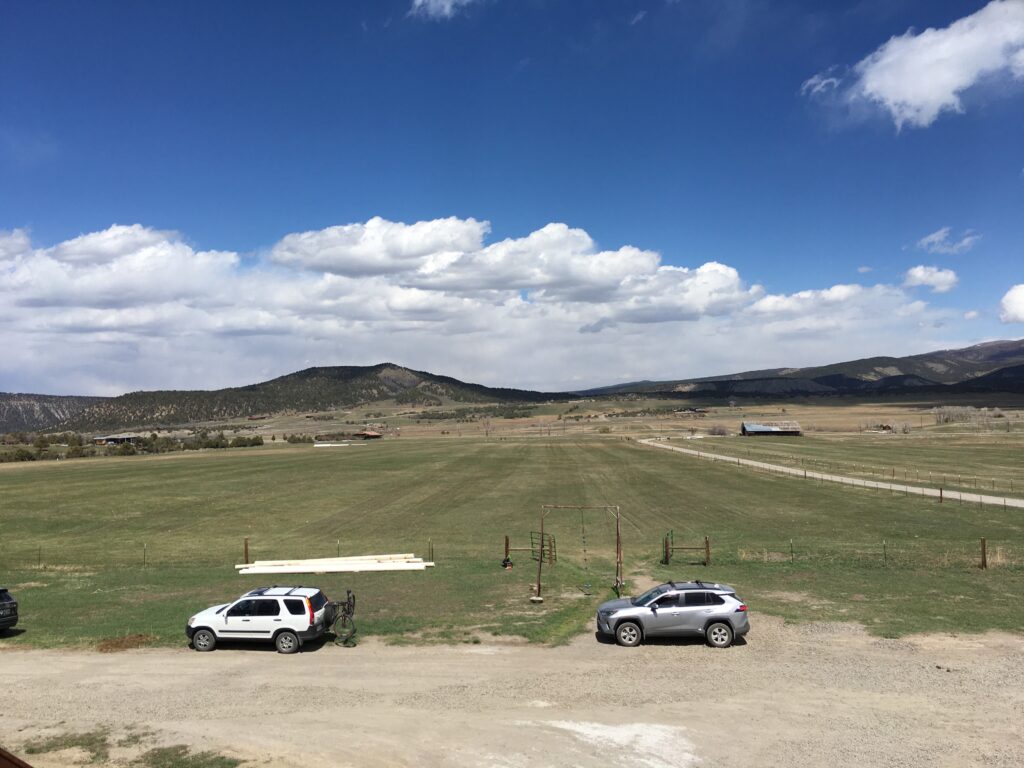
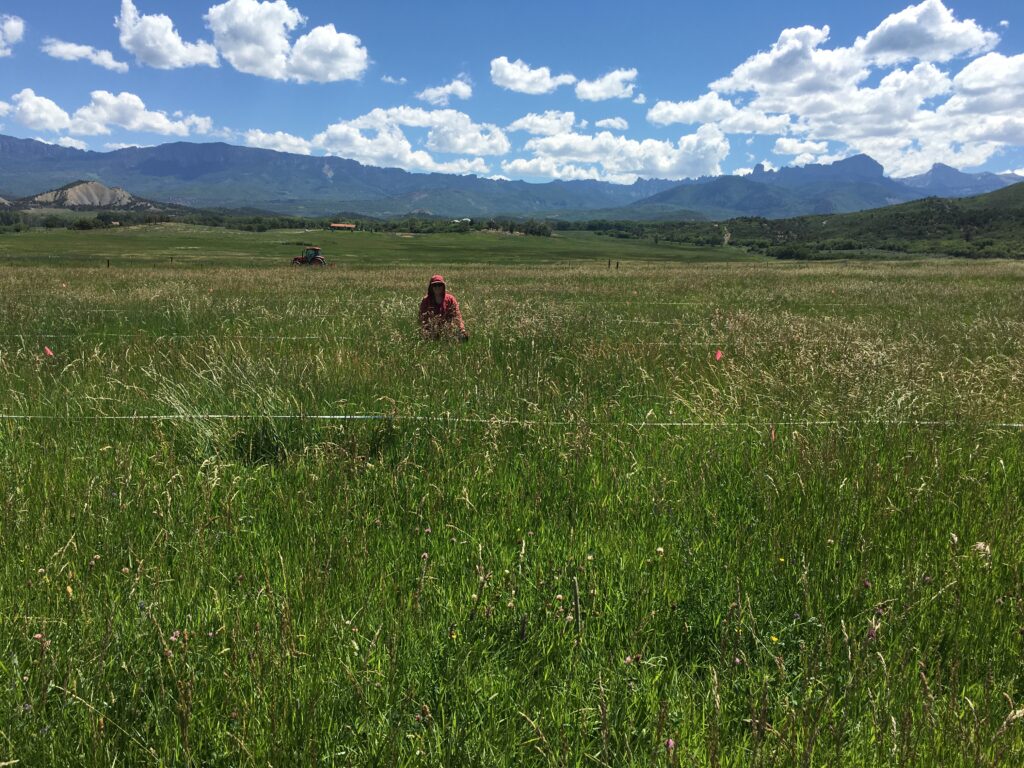
How does carbon get into soils in the first place?
There are two main factors that contribute to a soil’s ability to increase soil organic matter, much of which is comprised of soil organic carbon. Vegetative growth of plants is the engine that drives below ground soil organic matter, and clay in the soil binds to the organic matter so that it stays in the soil. Clay protects organic matter from decomposition by microbes and respiration back out to the atmosphere as CO2. On a purely sandy soil, even if you have lots of production, you will not see accumulation of organic matter.
In our region, we certainly have the clay. Compost application hypothetically affects the first factor needed to increase soil organic matter below ground by increasing production. In short, the dominant pathway to increased soil organic matter belowground is production aboveground, and this is the basic assumption behind using compost. To a lesser degree (though still significant), compost may also allow microbes to more efficiently integrate carbon if the chemistry of the compost more closely matches that of their bodies (stoichiometry).
What was measured?
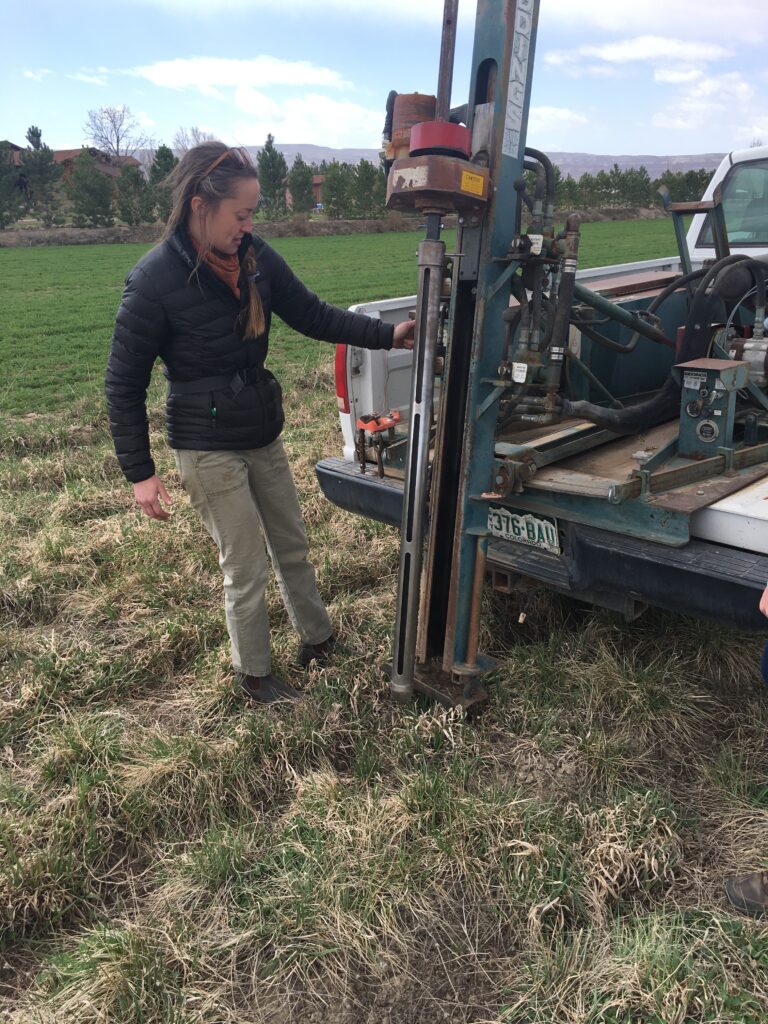
Vegetation
We measured grass hay yield, species composition and nutritional value.
Soil
For soil measured soil organic carbon at various horizons, C:N ratio, N stocks, bulk density and more. Soil health metrics analyzed are below.
- Carbon (TC, SIC, SOC)
- Nitrogen (NH4, NO3, TON)
- Phosphorus (Olsen P)
- POX-C (proxy for microbial/active carbon)
- Water holding capacity
- Beta-glucosidase (Microbial extracellular enzyme)
- PH
- Soil Respiration
- Water Stable Aggregates
- CEC (Cation Exchange Capacity) Salts
Above, Megan Machmuller demonstrates the Giddings probe, which we used to sample soils. We sampled to a depth of 1 yard, and collected 3 cores/plot. We then create an aggregate sample per plot by 4 depths, which we tested in the lab for the above variables.
Where did the experiment take place?
The experiment took place at the Grand Valley Research Station in Fruita, CO, and at a private field near Ridgway, CO. In each location, each treatment (i.e., compost, fertilizer, compost +fertilizer, or control) is replicated 3 times, for a total of 6 times between the two locations, and 24 plots total.
At right, Retta Bruegger and Megan Machmuller apply fertilizer to fertilizer-only plots. Fertilizer-only plots help contrast the impact of fertilizer versus compost.
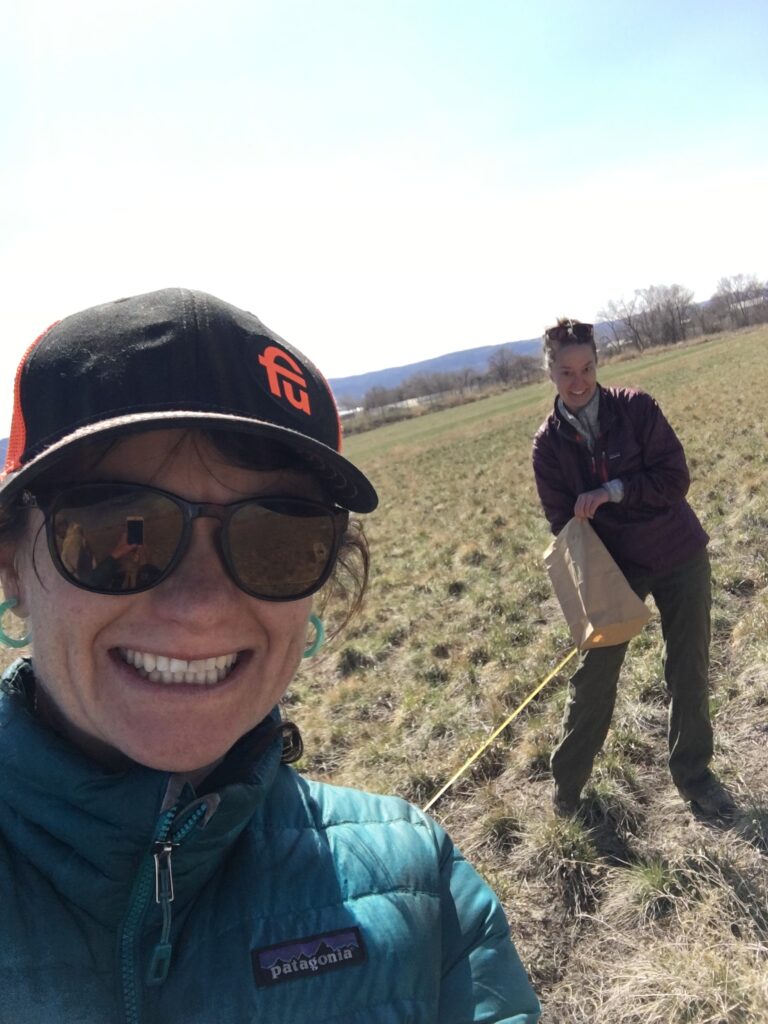
Results
Yield
- Compost plots were less productive (p = 0.008; 1,585 lbs/acre +458) compared to fertilized plots and were not different than controls (i.e., untreated).
- However, any negative effect from compost was not apparent in Year 2 (no differences among plots when management returned to fertilizer use in Year 2).
- Plots where fertilizer was applied in Year 2 were significantly more productive than non fertilized plots (p = 0.001745) in Year 2, but there was no difference among treatments from Year 1.
Soil Organic Carbon & Soil Health
- A 1-time application of compost did not increase soil organic carbon stocks. There were no differences among treatments at any horizon sampled.
- We detected no treatment effects on total nitrogen stocks.
- Despite high application rates, compost did not increase soil salinity.
- There were no treatment differences among treatments in soil health metrics analyzed.
Species Composition
- Exotic species did not increase on compost plots compared to other treatments.
- Ridgway only: Orchardgrass increased overall, except on fertilized plots (weak significance).
Other Studies
When compared with other studies, compost on irrigated pasture and rangeland has mixed results. A 2023 synthesis (Kutos et al. 2023) reviewed studies on rangeland and found that in 15 out of 37 studies, compost did not lead to an increase in soil organic carbon compared to the control. In 22 out of the 37 studies, compost did lead to an increase in soil organic carbon compared to the control. The same review showed that yield was not different in compost versus control in 50% of studies (Kutos et al. 2023). More locally, two studies from the Northern Colorado Front Range showed conflicting results on irrigated pasture (one study found an increase in soil organic carbon and the other found no increase – Mclelland et al. 2022 and Mikha et al. 2017). Given these results, our study was not anomalous. These results and the results of our study suggests that compost may not always lead to intended results of increasing soil organic carbon or production.
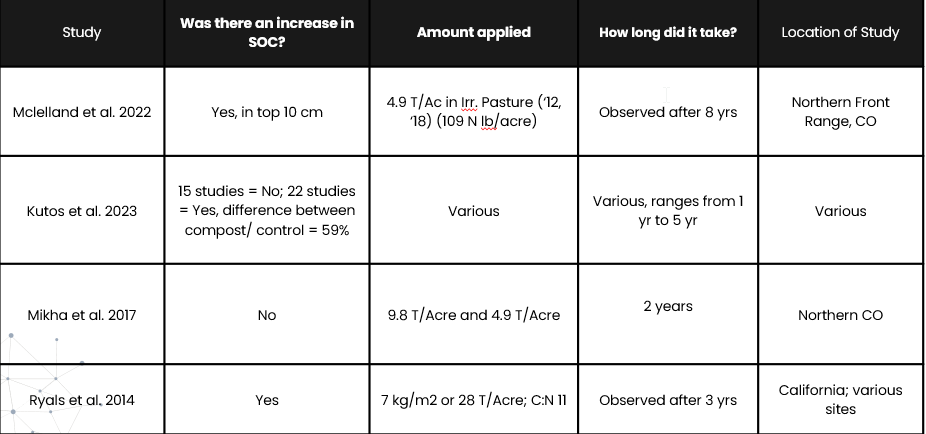
Economic Considerations
Below are our calculated rates comparing compost and fertilizer on this project.

Presentations
Funded by
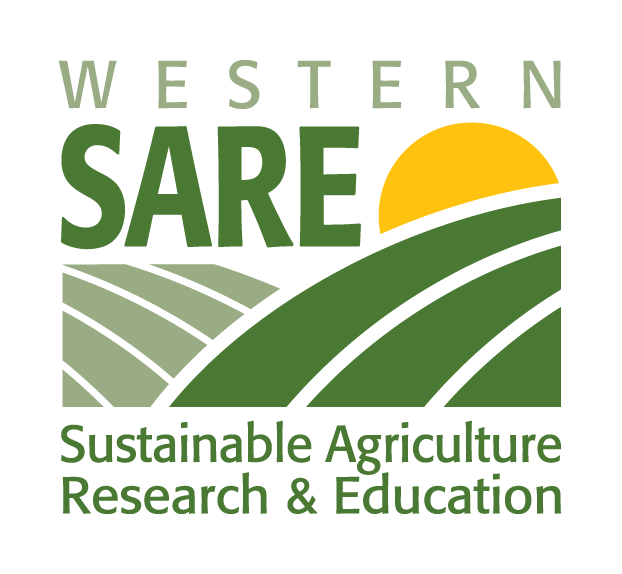

Thank you to the Grand Valley Research Station in Fruita, CO, especially Jim Fry and Perry Cabot for their help maintaining the field. Thank you as well to the Triple D Ranch in Ridgway, CO for their help in hosting the experiment in a second field. Finally, thank you to our stakeholders and the Shavano Conservation District for their support.
This material is based upon work that is supported by the National Institute of Food and Agriculture, U.S. Department of Agriculture, under award number G345-20-W7901 through the Western Sustainable Agriculture Research and Education program under project number OW20-358. USDA is an equal opportunity employer and service provider. Any opinions, findings, conclusions, or recommendations expressed in this publication are those of the author(s) and do not necessarily reflect the view of the U.S. Department of Agriculture.
Search:
Categories
- No categories


